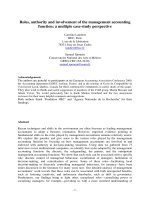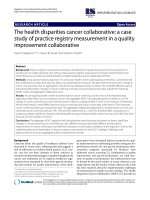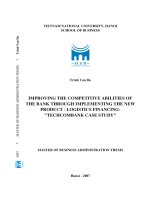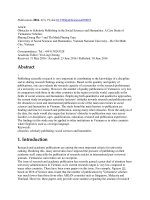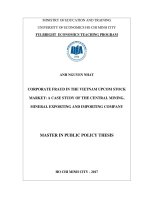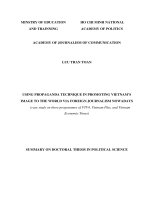Improving the competitive abilities of the bank through implementing the new product - logistics financing - Techcombank case study
Bạn đang xem bản rút gọn của tài liệu. Xem và tải ngay bản đầy đủ của tài liệu tại đây (1.16 MB, 101 trang )
1
vietnam national university, HANOI
school of business
Trinh Van Do
IMPROVING THE COMPETITIVE ABILITIES OF
THE BANK THROUGH IMPLEMENTING THE NEW
PRODUCT - LOGISTICS FINANCING-
"TECHCOMBANK CASE STUDY"
master of business administration thesis
Hanoi - 2007
2007 * master of business administration thesis *
Trinh Van Do
2
vietnam national university, HANOI
school of business
Trinh Van Do
IMPROVING THE COMPETITIVE ABILITIES OF
THE BANK THROUGH IMPLEMENTING THE NEW
PRODUCT - LOGISTICS FINANCING-
"TECHCOMBANK CASE STUDY"
Major: Business Administration
Code: 60 34 05
Master of business administration thesis
Supervisors: DR. Ta ngoc Cau
Hanoi - 2007
vi
CONTENTS
Acknowledgements
i
Abstract
ii
TÓM TẮT
iii
Key words
iv
Content
vi
List of Tables
x
List of Figures
xi
INTRODUCTION
1
1. Necessity of the thesis
1
2. Objective of the thesis
3
3. Methodology
5
4. Expert consulting
5
5. Descriptive survey
6
6. Contribution of the thesis
8
7. Thesis structure
9
CHAPTER 1: LITERATURE REVIEW
10
1.1. Competitiveness, competitive advantages and the importance of competitive
advantages.
10
1.1.1. Competitiveness and competitive advantages.
10
1.1.1.1. Competitiveness.
10
1.1.1.2. Competitive advantage
10
1.1.2. The importance of competitive advantage
11
1.1.3. Specific expression of competitive advantage.
12
1.1.3.1. Outweigh affectivity
12
1.1.3.2. High quality
12
1.1.3.3. Continual improvement
13
1.1.3.4. The ability to meet the demand of customers timely and quickly
13
1.2. Nature and process to realize sustainable competitive advantage
14
1.2.1. Source and process to recognize sustainable competitive advantage
14
vii
1.2.2. Sources, capability, key ability, exceeded capability and sustainable
competitive advantage.
14
1.2.2.1. Sources
14
1.2.2.2. Ability
15
1.2.2.3. Key abilities
17
1.2.2.4. Outweighing abilities
18
1.2.2.5. Competitive advantage and sustainable competitive advantage
19
1.2.3. Criteria of sustainable competitive advantages
20
1.2.3.1. Preciousness
20
1.2.3.2. Scarcity
20
1.2.3.3. The difficulty of imitation
21
1.2.3.4. A reasonable distance
22
1.2.3.5. Coincidence with factors of success
22
1.3 Functional field- The foundation to create sustainable competitive advantages
23
1.3.1 Production and operation management
23
1.3.2 Marketing
25
1.3.3 Material management
27
1.3.4 Research and Development (R &D)
28
1.3.5 Finance
28
1.3.6 Human resource
30
1.3.6.1. The planning of the labor source
31
1.3.6.2. Laborers enrolling
31
1.3.6.3. Training and Education
31
1.3.6.4. Salary and good-treatment- policy
32
1.3.6.5. Working relations
32
1.3.7 Customer relations and customer services
32
1.3.8 Building trademark and culture of enterprises
33
1.3.8.1. Building trademark
33
1.3.8.2. Building culture of enterprises
34
1.4.1. New service and product implementing
35
1.4.1.1. The new service and product definition
35
viii
1.4.1.2. Why do the firms design and offer new service and product
35
1.4.1.3. The development process of new service and product
35
1.4.1.4. Mass customization
38
CHAPTER 2: ANALYZING THE REAL SITUATION OF TECHCOMBANK
39
2.1. Techcombank overview
39
2.1.1. Techcombank history
41
2.1.2. The Techcombank mission statement and vision
44
2.2. Techcombank internal analysis
50
2.3. Competitive environment analysis
52
2.3.1. Macro competitive environment
52
2.3.2. Industrial competitive environment
54
2.3.3. Identifying the competitive advantage of Techcombank through
comparison with the same ones in banking field
56
2.3.4. SWOT analyzing
58
CHAPTER 3: PRODUCT DESCRIPTION
62
3.1. The features of Logistics Financing product
62
3.1.1. The conception of Logistics financing of Techcombank
62
3.1.2. The structure of Logistics financing of Techcombank
62
3.1.3. The value Logistics financing creating for its clients and Techcombank
63
3.1.3.1. The value Logistics financing creating for Techcombank
63
3.1.3.2. The value Logistics financing creating for its clients
66
3.1.3.3. Conditions to use the service
68
3.1.3.4. Procedure of purchasing the service
68
3.1.3.5. Logistics partners of Techcombank
69
CHAPTER 4: SOLUTIONS RECOMMENDATIONS AND CONCLUSION
70
4.1. The solutions
70
4.1.1. Providing unique products and its structures
70
4.1.1.1 How to be a unique product?
70
4.1.1.2. Solutions to structure of the bank
71
4.1.1.3. Solutions to system development
72
4.1.1.4. Solutions to structure of procedures
73
ix
4.1.1.5. Solutions to targeted customers and marketing
73
4.1.1.6. Solutions on human resources
74
4.1.1.7. Solutions to technology
75
4.1.1.8. Solutions to finance
76
4.1.1.9. Solutions to risk management
76
a. Credit risks management
77
b. Market risks management
78
c. Exploiting risks management
78
4.2 Recommendations
79
4.2.1 Recommendations for Techcombank
79
4.2.2 Recommendations for the Government
81
4.2.3 Conclusions
83
iv
Key Words
APPENDIX2. -LOGISTICS FINANCING BUZZ-WORDS-
1- In- transit stocks
2- In- transit assembly
3- Inventory control
4- Inventory management
5- Invoicing
6- Issuing delivery invoice
7- Just in time inventory
8- Link customer information system systems for electronic management of
supply chain process
9- Logistics management services
10- Localizations of products
11- Market research
12- Materials management
13- Merchandising
14- Modal analysis
15- Multi- modal management systems
16- Multi- package shipment processing
17- Online telecommunications
18- Order fulfillment
19- Order processing and control
20- Parts sequencing
21- Post production services
22- Pricing
23- Project cargo
24- Reduce inland transportation cost
v
25- Receiving report
26- Quality control
27- Quality assurance
28- Relocations
29- Remote spare parts distribution
30- Sailing advice
31- Sea/air
32- Shipment status report
33- Secure storage
34- Value added services
35- Warehouse and inventory
36- Warehouse localization
37- Vendor compliance
x
List of Tables
Tables. 2-1: Visible sources……………………………………………….15
Table. 2-2: Invisible sources………………………………………………16
Table. 2-3 : Criteria to define sustainable competitive advantages 21
Table. 2-4: The combination among sustainable criteria………………….22
Table. 2-5: The structure of culture of enterprises…………………………34
List of Figures
Figure. 2-1: New service or product developnt proces……………………37
xi
REFERENCES
Reference Books
Articles
Interviews
Internet sites
APPENDIX
APPENDIX 1 THE LOGISTICS FINANCING SERVICES QUESTIONNAIRE
APPENDIX2. -LOGISTICS FINANCING BUZZ-WORDS-
APPENDIX 3 -SUM OF THE QUESTIONNAIRE
APPENDIX 4- THE STRUCTURE OF TECHCOMBANK
1
INTRODUCTION
1. Necessity of the thesis
The thesis comes to take full advantages of the event Vietnam joined the
WTO. WTO has been creating a common market among its members, speeding up
commercial exchange and improving manufacturing. WTO really creates a playing
field for all countries including Vietnam. The open of the big market means
Vietnamese goods can be welcome in member markets. Similarly, Vietnam
becomes potential market for many importers, which brings about the busy
transaction activities among member countries. Through the penetration, Vietnam
has chances to learn experience and practice from other partners. Of which,
logistics seems to be an useful service used by foreign enterprises for such a long
time. The logistics has helped them to gain competitive advantages over other
rivals. Vietnam has no way but to do in line with common practice when joining
WTO. This means Vietnamese enterprises should be offered with such a new way
of trading oversea. By this way can Vietnam catch up with international practice of
doing business as well as improve trademark of goods and reputation of
Vietnamese enterprises.
The thesis is in line with the directions to find out new ways to diversify and
create competitiveness of Techcombank against other banks for its further
development in the future. The thesis offers theoretic condition to implement a new
service in addition to traditional ones such as deposit accounts, savings, loan,
payments, credit and debit cards, investment, guarantees and safe custody facilities.
Further more, logistics financing is an unique and completely new service which
can help Techcombank take priority over other rivals in the race to control the
potential market . The thesis also complies with the objective of Techcombank is to
strive its best for the benefit of customers and partly contribute to the development
of foreign trading.
Thesis comes timely to meet the demands of many clients who are in
difficulties. Under the signed agreement among WTO‟s members Vietnam have
2
many chances to access to the common market without being taxed on some items,
which creates favorable condition for Vietnam‟s products to penetrate into foreign
markets, especially into such prosperous but highly demanded ones as EU or
USA, etc. However, it isn‟t easy to make money in these hard-to-deal- with
markets. Doing business in the global market means all enterprises need to master
“rules of the game” and has enough conditions to be successful. Meanwhile, most
of Vietnamese enterprises are in shortage of capital, which makes them have few
chances to access to the loans from banks; out of date technology; weakness in
managing; inexperience of trading abroad and having no tools to minimize risks
floating up during oversea purchases. Further more, most Vietnamese enterprises
have difficulties in transaction due to lack of proper understanding and knowledge,
which often leads to the unexpected lawsuits and loss in trading affairs. To make
the matter worse, loan – given procedures of the banks are very troublesome, which
makes enterprises confused and prolong time for a purchasing affair. It is time
Vietnamese enterprises needed an agent which provides a full- service to help
them with import-export activities.
Another reason that makes the thesis necessary is to change the thought of
Vietnamese‟s importers and exporters. I‟d like to mention the disadvantages of the
old method of export- import which is used for such a long time. Exporters are used
to F O B (Free on Board) method which can be illustrated by the following process:
after receiving order enterprises focus on manufacturing, then they ask a bank to
open Letter of Credit ( L/C). After finishing with bank documents, they transport
goods to an assigned port, load on board then waiting till goods are delivered to
buyers. Buyers only pay the exporters via above bank after checking up for the
quality, quantity and model. The process seems to be very easy in theory but not
effective in practice because of some following reasons:
- It is a time- consuming method because it often takes from 20 to 40 days to
finish a trade (including time for checking up goods ), which leads to the shortage of capital.
- There are so many risks during shipping and checking up such as loss,
damage, fire or lack of hygienic condition of the goods, etc.
3
- Exporters and importers may be in trouble with international Laws in
delivery and clearance.
- There is high risk of information.
- Adding price of the products up because of the expenditure for freight,
insurance, employment and hygienic checking, this decreases the competitiveness
of the products and enterprises.
Similarly, C I F method (cost, insurance and freight) used by importers also
has the same problems which are mentioned above.
In the current context, no companies can cover everything in trade affairs.
To raise their competitiveness, they must outsource their weak points and focus on
their strength. This is an indispensable tendency of specialization Exporters-
importers should change their mindset by having a new and effective way of doing
business otherwise they may be left behind or fail in the “race” with foreign rivals
(According to statistics, a sum of around $3.4 and $3.9 billion USD spent in
transporting, insurance and checking run into the wallet of foreign enterprises every
year instead of that of Vietnamese ones).
2. Objective of the thesis
In the first part I have mentioned the necessity of the thesis. This section
will clarify the objective or the meaning of the thesis. The most important meaning
of the thesis is to define the long- term strategies of Techcombank. The three most
important strategies can be considered respectively as below.
First of all, Techcombank focuses on big customers in import-export field.
On what bases that Techcombank decided to give out such strategy? Just have a
look at the past of Techcombank. At the beginning, Techcombank was a small
bank and its customers were only small and medium enterprises ( SMEs). It was
the limited capital that prevented it from targeting at big clients. Nowadays,
Techcombank has grown to become one of the largest and fastest growing full
4
service joint-stock banks in Vietnam with the registered capital of VND 1,500
billion, total assets of nearly VND 15,000 billion. Once its financial power reaches
to an extent , Techcombank finds it timely to focus on bigger and more potential
clients. Besides, we can not take into consideration objective reality that such
traditional and small enterprises as Hoa Phat and Nam Vang, etc have developed
into big corporation. They are now still using services provided by the
Techcombank and of course they will still be in the limelight of the bank.
Furthermore, it is big enterprises that use logistics service more frequently
compared to small and medium ones. That is because operation of big enterprises
often spreads widely both literally and figuratively and closely attaches to logistics
service. They not only need a lot of money from the bank, usually in long term or
medium term loans, but also need Techcombank to help with processing,
packaging, transporting or providing market information and legal consulting, etc.
And such subsidiary services will be a channel to lure money for the bank. For
short, the more big enterprises use the services the more money Techcombank gets.
It is really a bilateral benefit relationship. Additionally, the risks ( bankruptcy,
overdue loans, etc ) sprouting during the time trading with big customers are
somewhat fewer than that with small enterprises.
The second long-term strategy given out by Techcombank is to expand its
credit services. As you know, Techcombank offers a variety of credit services
including savings, deposit accounts, savings, loan, payments, credit and debit cards,
investment, guarantees and safe custody facilities, etc and the total amount of
exchanged money is considerable. Besides such traditional services, Teccombank
targets at new services such as providing full-service for enterprises especially
SMEs or promoting non-credit service,etc. Logistics comes to meet the demand.
The third but most important strategy of Techcombank is to improve its
competitiveness against other banks. As you see, in the current context, there are so
many banks operating in this field and offering the same services as Techcombank.
Not mention the fact that some of them are really giant and experienced in terms of
5
size, capital and time of operation. Unless Techcombank finds new methods, it may
have difficulties in competing with such banks. Morover, Logistics is a new but
potential market in the context of development of foreign trade. It can be said
without exaggeration that logistics is the unique service given out by Techcombank
that appears in Vietnam for the first time. The service strongly supports enterprises
from the beginning to the end of a trade transaction. The bank helps its customers
with money, logistics, custom document, processing, packaging, market
information, legal document, etc which are often considered burden of the
enterprises. By such new service can Techcombank make itself different from other
banks. This is also a favorable condition to help Techcombank outruns other rivals
in the race to master the market.
3. Methodology
The thesis bases on the results of the two idea-collecting methods: expert
consulting and survey.
4. Expert consulting
To be able to get information on some topics for which, neither time nor
resource were sufficient, this strategy is strengthened by the advantage of utilizing
expert knowledge. The expert knowledge information is collected as primary data
designed for only this strategy design purpose. This seems to be the useful source.
However, the experts consulted, information-needs, also have that in common the
information data is qualitative. It seems to be impossible to find the exact
information, analysis or figure through this channel of expert. It does not consist of
exact situation, more the respondents conclusions on the case.
Below follow one information-need for which experts were consulted and
the methodology is discussed. The methodology execution means the choice of the
responding consultant and the formulation of the question.
At first, the time demanding investigation was made by us, gathering the
competitors' logistics service offerings on the Internet. It is easy to observe that
6
Techcombank offers a very new service that no competitor can compare because
other competitors are just the normal logistic provider. They just do the logistic
service then get money from the customer hire them, when their task is completed,
then the service is stop. For Techcombank, we supply the financial logistics
services – an outstanding and professional one. However, we still pay attention on
big and long-lasting logistic provider in the market that share our same cake. In
order to sort out the big main competitors, an expert was asked to pick out the most
important activities and to explain them. As this is a question of a logistics
character, the best man to answer a question like this, must be a professor in
Logistics, which is why the choice fell on one experienced logistics professors –
Mr Duong Duc Tang, the Director of Vinafco Logistic.
The consultant we used, Professor Vu Dinh Quang, is of good repute within
the logistics field. The answer would naturally not be the same if put to another expert,
but if to an at lest as experienced professor the answers would likely be close. The
difference in answer depends on, that it is a qualitative question, which is often totally
dependent on the perception of the judged environment by the respondent.
5. Descriptive survey
The third research method we will use in our thesis, to be able to collect
primary data is a descriptive survey. A descriptive survey is concerned primary
with addressing the particular characteristics of a specific population of subjects,
either at a fixed point in time or at varying times for comparative purposes. Of
great interest is the underlying target population that the surveyed samples are
supposed to represent.
When the population is small, it is often practical to study all units, a so-
called total survey (Lekvall & Wahlbin, 1993 p. 144). The population we want to
study only consists of (Number) units and we will therefore make a total survey.
A population is usually defined with help from a register or a frame of the
units that the population consists of. It is then important that there are no big
7
differences between the frame and the population that is going to be studied. When
all units in a register that are not part of the target population are cut out, a frame
selection remains (Lekvall & Wahlbin, 1993 p. 154). The frame selection in our
survey is Techcombanks‟s branches in the cities and provinces of Viet Nam
However, when we do the survey, there are three broad sources of errors,
sample error may likely to arise. The survey we will undertake is a total survey of
all Techcombank‟s branches. Consequently, the issues of the surveyed samples and
sample error (population validity) will not affect the outcome of the survey. The
second source of error, frame error refers to biases of the result that depend on a
mismatch between the frame of sample and the target population. A frame for
example arises when the telephone directory is used as a register population. The
problem with a telephone directory as a register population is that all people do not
have a phone, some people have unlisted numbers and others have just moved in.
Since our survey is directed at Techcombank‟s branches, there certainly exists an
updated directory of offices that should be included. The risk of a frame error is
thus extremely small.
The third source of error, dropout, is more relevant in our survey. Dropout
means a failure in getting all data that is needed for the survey. Some data fall off
in the data collection process. The most significant measure to restrict the dropout
is to have a clear and not too expensive questionnaire. Long and complicated
questionnaires are in general devastating for the willingness to answer. Other
measures to secure a high participation, are to contact the respondents in advance
and inform them that a questionnaire is being sent out, give respondents some kind
of reward, or remind them if they have not returned the questionnaires.
It is important that the person that should answer the questionnaire really
does this. The questionnaires are sent to the managers that have most knowledge of
the activities taking place in each cities, regions. To control this, we have questions
about name and title of the respondents in the questionnaire.
8
6. Contribution of the thesis
It can be said without exaggeration that the thesis makes great contribution
on different levels from the State to Techcombank and its customers.
For the State, logistics links directly to its budget via tax collecting. As
mentioned above, Logistics makes the way for the development of enterprises.
Thanks to the logistics financing of Techcombank, enterprises are no longer
worried about capital, shipping, storage or related information, etc. All they need to do
is to focus on manufacturing. Consequently, the more enterprises develop, the more
money they earn. Similarly, the more money they earn, the more they contribute to the
State budget through tax handing in. In my opinion, logistics financing should be
warmly well-come for its active contribution to the national economy.
For customers, the most important contribution that the thesis makes is to
change their old mind-set of doing business oversea because of the indispensable
advantages. First of all, it provides them with a new service which help them save
time and money, feel secure about their goods in stocks, limit possible risks as well
as shorten time and money circulation. Secondly, the thesis will also help them get
used to a professional way of importing-exporting which is now used by plenty of
foreign partners. So that they won‟t get into trouble with unexpected lawsuits
claimed by foreign companies and have more chances to improve their trade marks
as well as reputation. As you know, the trade- mark polishing plays a very
important role in doing business oversea because of the fact that foreign markets
only accept products with proved trade- marks. Techcombank with its service
commits strongest support to maintain goods quality of the clients.
For Techcombank, the thesis makes great contribution to raise its market
share by expanding number of customers (especially ones in export-import field),
raise net profit (via offering numerous services), and better control its money in
goods-deposited loans. The most importantly, the thesis will raise its
competitiveness against other banks as the first bank to deliver such initiative. It
9
can be considered a meaningful way-out in the current context that finance market
is nearly saturated by numerous banks in operation.
7. Thesis structure
The thesis is divided in 5 main chapters namely Introduction, Literature
Review, The Research Methodology and Data Collection, Analyzing the real
situation of Techcombank and Strategic Solution recommendations and Conclusion
(Besides there are two supporting parts namely Reference and Appendix at the end
of the thesis). Each chapter has its own function and relative independence from
other ones. However, the older of the chapters are not by accident but symbolizes
an internal link among them. Inside each chapter, there also have sub-parts which is
to supplement for the main topic of the chapter.
10
CHAPTER 1: LITERATURE REVIEW
1.1. Competitiveness, competitive advantages and the importance of
competitive advantages
1.1.1. Competitiveness and competitive advantages
1.1.1.1. Competitiveness
Competitiveness (defined by the Vietnamese dictionary which was
published by the Culture and Information publishing House in 1999) is the
campaign among individuals and collectives which have the same function in order
to gain the success.
In competitive environment, there is no bloody fighting among rivals as
usually seen in army. They just compete against each others to control potential
markets and lure customers, It‟s customers who decide which “win” or “fail” in
such combats by their decisions to use services and products.
The winner is someone who meets demands of customers. In the current
context of international economic integration and globalization, the confrontation
in competitiveness has been replaced with peace and cooperation for mutual
benefits. A series of strategic cooperation between SONY_ERICSSON and Dow
Chemical &United Technologies come as an example of the trend.
Via cooperation, two or more companies can share risks, expenses as well as
benefits relating to developing new chances of doing business. Cooperation is now
becoming a common trend which helps enterprises improve their market ability and
expand their market shares as well.
1.1.1.2. Competitive advantage
Competitive advantage- in broad meaning- is anything that enable an
enterprise to outweigh over its rivals. Competitive advantage creates favorable
conditions for enterprise to maintain its sustainable success (Strategic
management- The Statistics Publishing House, 2007).
11
According to teaching materials of economics, an enterprise is considered
competitive when its benefit is higher than the average level of the market and
much higher than that of its rivals. Basically, competitive advantage includes
advantage of expense and of difference.
- Advantage of expense means an enterprise can supply the same kind of
products or services given by its rivals at lower expenses, which will help the
enterprise offer lower price and gain more profits.
- Advantage of difference means only enterprise can provide such products or
services. In case customers are not sensitive, enterprise can speed up selling price
of its products or services and get more profits.
1.1.2 The importance of competitive advantage
In the current context of integration and development, each enterprise has its
own way of existence and development. However, the only way to reach such goal
is to set up strategies and maintain competitive advantages. A common strategy
will help enterprise maximize its strong points as well as self-defense against bad
effects of 5 market forces namely strength of suppliers, threat to be replaced,
barrier of joining, strength of customers and competitiveness level.
The position of enterprises are preceded by the attractiveness of the industry
in making profits . Even such industry has an average profit making ability,
enterprises can get very high profits if they have optimal position.
Each company finds its place in the industry by taking advantage of any
own strong points. Michael Porter said that advantage of any enterprises comes
from 2 factors: expense advantage and the isolation of products. By taking such
advantages do companies create competitive advantages via pursuing 3 common
strategies: leading in saving expenses, isolating products and centralizing as well .
Competitive advantage enables many enterprises to gain “market power” so that
they can succeed in business and competition. It is important to understand
thoroughly nature and sources which give birth to competitive advantage in order
to set up and maintain it sustain ably.
12
1.1.3 Specific expression of competitive advantage
As mentioned above, there are 4 factors creating competitive advantage
namely outweigh affectivity, different quality, continual improvement and the
timely satisfaction of demand of customers. Whichever industry does the company
do, whichever products/services does the company provide the company must meet
the 4 factors. It is necessary to note that each of the four factors has close relations
with the others.
1.1.3.1. Outweigh affectivity
Company is a tool to turn input into output. Input is basic factors of
manufacturing such as labor, infrastructure, capital, management and technique.
Output includes goods, services made by the company. The simplest formula of
efficiency is that Efficiency= Output/Input. The more effectively a company does
business, the less output it needs.
The most important factor bringing about the success of any companies is labor
productivity which is valued via the number of products made by each employee. If
owning high labor productivity, the company will cut down on production cost
maximally, which partly contributes to build competitive advantage.
1.1.3.2. High quality
Quality products mean ones with confidence. Let take Toyota Corp, The
Gap and the customer service of City Bank as examples of providing quality
products and services. Quality may double the competitive advantage of
enterprises. When a company supplies a good quality product it succeeds in
winning the confidence of customers. If it maintains such value, it can change price
of such item in a way that gives it more benefits.
The effect of high quality on competitive advantage comes from high
affectivity and lower expense. Shorter time means employees must work with
higher efficiency to create higher productivity. As a result a company not only
lowers expense but also raise selling price.
13
1.1.3.3. Continual improvement
Improvement can be understood as anything new and unique that company
applies to make goods. Improvement includes the ability of taking advance against
other rivals in terms of design, manufacturing process, and management system
and development strategies of a company.
The improvement is an important factor to create competitive advantage. In the
future, the competitiveness can be affected by improvements. Although not all
improvements are successful, otherwise, they will become strength which helps
enterprise get competitive advantage. That it because they make enterprise unique and
different from its rivals , which also speeds price of its products or services up and
lowers production expense.
Along with affectivity and quality, we will have a more detail look on
improvement. Let take the development of Xerox photocopy machine, Intel micro
processor, Hewlett Packard laser printer, Nike sport shoes, Walkman as examples
of the importance of improvement. It is unique features in each product that makes
money for such companies. When their rivals could imitate such improvements,
companies had strengthened their places in the market.
1.1.3.4. The ability to meet the demand of customers timely and quickly
To achieve such target, a company has to do better than other companies of
the same field and satisfies customers. If customers highly value such products of
the company, it will gain competitive advantage via its difference from other rivals.
Quality improvement of products means the ability to understand the taste of
customers then create a product which has features that no other products do. To
tell in other ways, ensuring quality and improvement means enabling to meet the
demand of customers.
A factor to satisfy customers is to define a certain product that meets the
demand of each individual or collective. For example, a series of alcoholic drinks
and beers in recent years are efforts made by beverage companies to meet the
demand of customers.
14
Another factor that enterprise should pay attention to is to define the most
suitable time to introduce its products. That is because a suitable time will help
enterprise attract customers‟ attention in the most effective way.
Along with quality and time, customers also pay attention to design, service
quality and after –sale service. All such factors will increase competitiveness, meet
the demand of customers. So that they strengthen the position of company in the
market as well as raise price of products.
In general, outweighing affectivity, higher quality, the ability to satisfy
customers and continual improvement are very important in creating competitive
advantage which enables the company lower expenses or raise price of products.
1.2 Nature and process to realize sustainable competitive advantage
1.2.1 Source and process to recognize sustainable competitive advantage
An enterprise only competes successfully in the market when it outweighs
over its rivals. Such strong points of the company come from the difference of
products, the difference of its image and services, which is competitive advantage
of enterprise. Competitive advantage can either last for long or short time. As a
result, to exploit short time advantages and maintain long lasting ones, each
enterprise must analyses competitive advantage in detail to choose a suitable
competitiveness strategy.
1.2.2 Sources, capability, key ability, exceeded capability and sustainable
competitive advantage.
1.2.2.1. Sources
Sources- in broad meaning- are composed of a series of factors relating to
structure, technique, labor, finance of the company. In other criteria, source can be
divided into 2 types namely invisible and visible source. Visible sources consist of
what can be seen and determined the quantity of such as finance source, structure,
material conditions and technology. Trademark, recognition, strategic position,
inventions can be named as invisible ones.
15
In comparison with visible sources in creating key ability, invisible sources
seem to outweigh. There is saying that “success of a company depends much on
intellect and systematic sources other than material properties. Moreover, the
ability to control human intellect and turn it into products or services has become a
common trend in managing in the current context”. There are many evidences
showing that the proportion between invisible sources and visible ones has been
unequal and invisible sources seem to outrun visible ones. That is because it is
difficult for enterprises to recognize or imitate, buy, and replace such invisible
sources of the others‟. As a result, enterprises prefer creating their abilities as well
as key ability on the bases of invisible sources to visible ones.
Table 2-1: Visible sources
Source
Content
Labor force
- Knowledge
- Creditability
- Managing abilities
- Structural habits
Financial sources
- Borrowing ability
- Self-capitalizing ability
Structural sources
- Official system of planning and
coordinated controlling
Material sources
- The complicity and the
distribution of equipments and
workshops
- Access to sources of materials
Technical sources
- Technical reserves such as
trademark, invention license as
well as business secrets.
Source: The strategic Management- The Statistics publishing House, 200
As you all know, sources themselves can not give birth to competitive
advantage for company. To become special ability, sources must be unique and
valuable. That means there are no other companies have the same sources.
Sources are considered valuable when they can create strong demand for
products of company.

